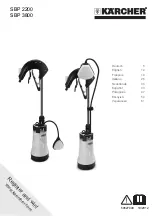
16
ALL UNITS
Test the GFCI receptacle by pressing the TEST button on the
face of the receptacle to trip and open the receptacle. Check for
proper grounding wires and power line phasing if the GFCI re
-
ceptacle does not trip as required. Press the RESET button to
clear the tripped condition.
Unit-Mounted Convenience Outlets
Outlets will often require that 2 disconnects be opened to de-
energize all power to the unit. Treat all units as electrically
energized until the convenience outlet power is also checked and
de-energization is confirmed. Observe National Electrical Code
Article 210, Branch Circuits, for use of convenience outlets.
Fuse on Power Type
The factory fuse is a Bussman “Fusetron”
1
T-15, non-
renewable screw-in (Edison base) type plug fuse. See Fig. 28
for maximum continuous use amp limitations.
Fig. 28 — Convenience Outlet Utilization Notice Label
FACTORY-OPTION THRU-BASE CONNECTIONS
(ELECTRICAL CONNECTIONS)
This service connection kit consists of a 1/2
in. electrical bulk
-
head connector and a 1-1/2 in. electrical bulkhead connector,
connected to an “L” bracket covering the embossed (raised)
section of the unit basepan in the condenser section. See
Fig. 29. The 1/2 in. bulkhead connector enables the low-
voltage control wires to pass through the basepan. The 1-1/2 in.
electrical bulkhead connector allows the high-voltage power
wires to pass through the basepan.
Fig. 29 — Thru-the-Base Option, Shipping Position
1. Remove the “L” bracket assembly from the unit.
2. Remove connector plate assembly from the “L” bracket
and discard the “L” bracket, but retain the washer head
screws and the gasket (located between the “L” bracket
and the connector plate assembly).
NOTE: Take care not to damage the gasket, as it is reused in the
following step.
3. Place the gasket over the embossed area in the basepan,
aligning the holes in the gasket to the holes in the basepan.
See Fig. 30.
4. Install the connector plate assembly to the basepan using
8 of the washer head screws.
NOTE: If electrical connections are not going to occur at this time,
tape or otherwise cover the fittings so that moisture does not get
into the building or conduit in the interim.
Fig. 30 — Completing Installation of Thru-the-Base Option
Check tightness of connector lock nuts before connecting elec
-
trical conduits.
Field-supplied and field-installed liquid tight conduit connectors
and conduit may be attached to the connectors on the basepan.
Pull correctly rated high voltage through appropriate conduits.
Connect the power conduit to the internal disconnect (if unit is
so equipped) or to the external disconnect (through unit side pan
-
el). A hole must be field cut in the main control box bottom on
the left side so the 24-v control connections can be made.
Connect the control power conduit to the unit control box at
this hole.
Units Without Thru-Base Connections
1. Install power wiring conduit through side panel openings.
Install conduit between disconnect and control box.
2. Install power lines to terminal connections as shown in
Fig. 22.
Field Control Wiring
The 547K*14 requires an external temperature control device.
This device can be a thermostat (field-supplied) or a thermostat
emulation device provided as part of a third-party Building
Management System.
Thermostat
Install a Bryant-approved accessory 2-stage Cooling/Heating ther
-
mostat according to installation instructions included with the
accessory. If using an electronic thermostat, configure it for “non-
heat pump” operation. Locate the thermostat accessory on a solid
wall in the conditioned space to sense average temperature in ac
-
cordance with the thermostat installation instructions.
If the thermostat contains a logic circuit requiring 24-v power,
use a thermostat cable or equivalent single leads of different
colors with minimum of 7 leads. If the thermostat does not re
-
quire a 24-v source (no “C” connection required), use a ther
-
mostat cable or equivalent with minimum of 6 leads. See
Fig. 31. Check the thermostat installation instructions for addi
-
tional features which might require additional conductors in
the cable. For wire runs up to 50 ft (15 m), use no. 18 AWG
(American Wire Gauge) insulated wire 95°F (35°C minimum).
For 50 to 75 ft (15 to 23 m), use no. 16 AWG insulated wire
(35°C minimum). For over 75 ft (23 m), use no. 14 AWG insu
-
lated wire (35°C minimum). All wire sizes larger than
no. 18 AWG cannot be directly connected to the thermostat
and will require a junction box and splice at the thermostat.
1. Bussman and Fusetron are trademarks of Cooper Technologies
Company.
0.5” Electrical
Bulkhead
Connector
1.5” Electrical
Bulkhead
Connector
Gasket
Connector
Plate
Assembly
Содержание Legacy 547K 14
Страница 4: ...4 Fig 2 547K 14 Unit Dimensional Drawing...
Страница 5: ...5 Fig 2 547K 14 Unit Dimensional Drawing cont...
Страница 8: ...8 Fig 5 547K 14 Roof Curb Details...
Страница 21: ...21 Fig 41 Typical Control Wiring Diagram Electromechanical with W7220 Controller...
Страница 22: ...22 Fig 42 Typical Power Wiring Diagram 208 230 460 3 60 Unit Shown...
Страница 23: ...23 Fig 43 Typical Power Wiring Diagram 575 3 60 Unit Shown...
Страница 41: ......
















































